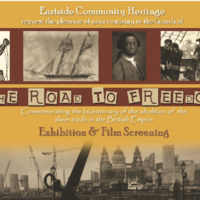
The Road to Freedom
Eastside Community Heritage worked with young people from West Ham and Stratford to explore the significance of the bicentenary within the context of their own history in London and in British history more widely. The Road to Freedom project was devised by the young people themselves, who gathered information from the Museum of London Docklands, the National Maritime Museum, the International Slavery Museum and the Birmingham Museum and Art Gallery. Their research led to a documentary-drama and an exhibition which toured venues in Newham, accompanied by discussion sessions led by the participants.
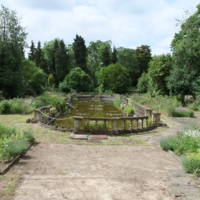
Liberation Song
Easton Lodge is a historic estate in Essex, with gardens open to the public. The Gardens of Easton Lodge Preservation Trust led two projects to mark the bicentenary. Liberation Song involved three local schools working with Grand Union Orchestra to explore the roots of musical instruments and styles, culminating in a community concert. A visual arts project involving seven local schools examined the history of Easton Lodge and trading links during the 18th century. Children decorated and displayed cotton reusable carrier bags and displayed them on yew hedges in the gardens. Connections were made with the story of the 18th century Ghanaian anti-slavery campaigner Ottobah Cugoano and the modern day Fair trade movement.
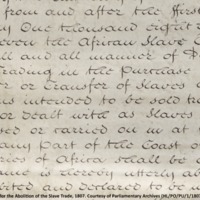
For Love of Sugar
Commissioned by 2007's City of London Festival, artist Satch Hoyt created several sculptures made only of sugar. In St Paul's Cathedral, life-sized portraits of influential black figures - including Olaudah Equiano, Ignatius Sancho and Mary Seacole - were made of painted sugar cubes. Hoyt also created two slave ships from sugar, displayed at Museum of London Docklands.
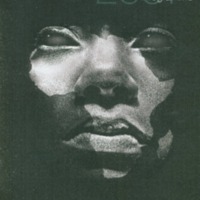
2007 Bicentenary for the Abolition of the Slave Trade Act at the National Maritime Museum
The National Maritime Museum marked the bicentenary with a range of initiatives and events including a new exhibition, a film season, poetry, music, debates, and new publications. A new permanent gallery opened at the museum in winter 2007 exploring Britain's Atlantic empire. A catalogue of slavery-related images, artefacts and documents from the collections of the museum, 'Representing Slavery', was published. The museum also devised a transatlantic slavery trail around Greenwich.
The National Maritime Museum hosted a number of events throughout 2007. The theme of the weekend 23-25 March was 'And still I rise', marked with a series of activities, performances and discussion. On August 23, International Day for the Remembrance of the Slave Trade and its Abolition, the ‘Freedom Festival: Contemporary Commemoration’ event saw a programme of creative events and performances exploring themes around the heritage of enslavement. The museum also offered a range of learning experiences based on its collections. For example, in November, a study session, 'Roots of Resistance: Abolition 1807' examined the roots of resistance and the abolition movement through talks by curators and contemporary artists. Activities for families were based on themes of freedom and carnival. 'The Big Conversation 2007' was a programme of debate and showcasing of diverse projects undertaken by students around the country, organised by the Understanding Slavery Initiative and the Department for Children, Schools and Families.
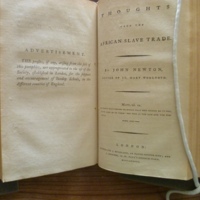
From Slave Trade to Fair Trade
The Cowper and Newton Museum is located in Olney, Buckinghamshire, in the building that was once the home of the 18th century poet William Cowper. The Reverend John Newton - formerly master of a slave ship - was Cowper's great friend, and wrote the abolitionist hymn 'Amazing Grace' in collaboration with Cowper whilst living in Olney. The museum's exhibition From Slave Trade to Fair Trade involved a reinterpretation of the museum's collections relating to slavery and abolition. The wider project also included a number of events and community engagement activities, in partnership with Milton Keynes Local Authority, Global Education Milton Keynes (GEMK), the charity World Vision and Culture Milton Keynes. Local black and minority ethnic groups worked with the museum on performances of poetry and readings associated with slavery. A touring display about John Newton and the transatlantic slave trade was shown in various schools, libraries and other locations in Milton Keynes throughout 2007. In April that year, the museum commemorated the bicentenary of the Abolition Act and the death of John Newton with a weekend of talks, tours, church services and a concert from the Todd Murray Group choir.
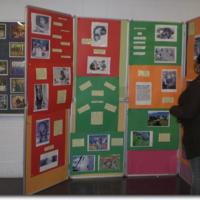
Commemorating 1807
A day of activities to mark the bicentenary was held in November 2007 at Forest Gate Youth Zone, a young people's drop-in centre in the London Borough of Newham. The day included an exhibition, workshops and performances.
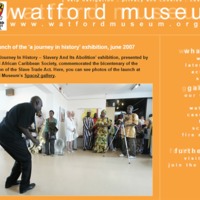
A Journey in History: Slavery and Its Abolition
A Journey In History: Slavery And Its Abolition was an exhibition presented by Watford African Caribbean Society to mark the bicentenary of the Abolition Act. The exhibition was launched at Watford Museum's Space2 gallery in 2007. Photographs of the launch are available on Watford Museum's website.
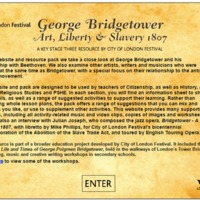
George Bridgetower: Art, Liberty and Slavery 1807
In this website and Key Stage 3 Resource Pack, the City of London Festival examined the work of the Afro-European violinist George Bridgetower (1778-1860) and, in particular, his relationship with the composer Ludwig van Beethoven. The resource also explored the role of other artists, writers and musicians who were active at the same time as Bridgetower, with a special focus on their relationships to the anti-slavery movement. The website provided music, video clips and worksheets, alongside an interview with Julian Joseph, composer of the jazz opera Bridgetower - A Fable of 1807, toured by English Touring Opera. The resource was part of a broader education project developed by City of London Festival, which included the exhibition, 1807: The Life and Times of George Polgreen Bridgetower, held in the walkways of London's Tower Bridge. The education project also included storytelling, music and creative writing workshops in secondary schools.
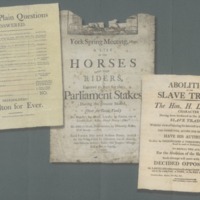
Harewood 1807
2007 saw a number of different projects taking place at Harewood House in West Yorkshire, home of the Lascelles family. The bicentenary was used as an opportunity to explore the family connections with the transatlantic slave trade and the sugar plantations of the West Indies.
As part of a newly developed Learning Programme, leaflets were produced setting out the family connections to Barbados. 2007 also marked the bicentenary of the Yorkshire election in 1807 contested by William Wilberforce, Henry Lascelles (later 2nd Earl of Harewood) and Lord Milton. Competition between the candidates was fierce, based on issues such as Catholic Emancipation, poverty, workers' rights and abolition of the slave trade.
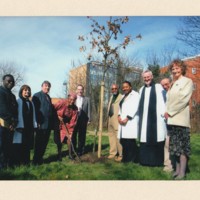
Events led by Leyton and Leytonstone Historical Society
The Leyton and Leytonstone Historical Society led a number of commemorative events to mark the bicentenary. In March 2007 an oak tree was planted in the churchyard of St John’s Church Leytonstone. At the ceremony there were a number of speeches, after which community nurse and local campaigner Mrs Zena Edmund-Charles was invited to plant the commemorative tree. There was also an art exhibition at St John's featuring artefacts and mementos of the period. A commemorative ‘Freedom Walk’ was led by local historian Peter Ashan, following a route around Leyton, Leytonstone and Walthamstow. The exhibition was shown again during Black History Month, alongside a video story of Olaudah Equiano.
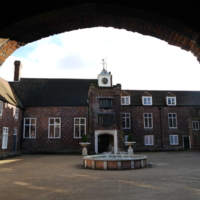
Faces of Freedom: Hammersmith and Fulham and the Slave Trade
The Museum of Fulham Palace is housed in the former palace of the Bishops of London, and former home of Bishop Porteus, the leading advocate for abolition within the Church of England in the late 18th and early 19th centuries. The Faces of Freedom exhibition featured Porteus alongside other individuals associated with slavery and abolition who had links with the area. The abolitionist Granville Sharp lived and is buried nearby, while Crisp Road was named after the slave trader and bead manufacturer Sir Nicholas Crisp. The exhibition included glass beads (very likely produced to be used for barter in Africa) excavated by the Museum of London on the site of Crisp's Hammersmith home. Also featured was the story of Ellen and William Craft, fugitive slaves from Georgia who made Hammersmith their home, and the contributions of local residents Marcus Garvey, Jamaican Pan-Africanist, and nurse Mary Seacole. The exhibition included video footage and posters relating to slavery and freedom, created by pupils from the nearby Phoenix High School.
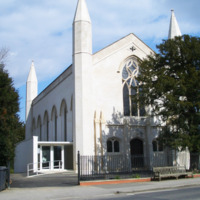
Celebration of the Bicentenary of the Abolition of the Atlantic Slave Trade
After 1825, on leaving Parliament, William Wilberforce retired to Hendon Park in Mill Hill, North London, and during his retirement built a chapel on his estate, now St. Paul's Church. St. Paul's organised a programme of events in 2007 to mark the bicentenary, including concerts by The London Community Gospel Choir and The St. Ignatius Gospel Choir. A series of exhibitions in London Borough of Barnet libraries explored Wilberforce's local connections, and visits to local schools encouraged pupils to express their understanding of slavery and abolition in art, and stressed the need to continue the work of abolitionists today. The programme also included a number of open public meetings with invited speakers exploring different aspects of Wilberforce's life and work, including his collaborations with Thomas Clarkson and John Newton. In 2008 the Wilberforce Centre was opened in the crypt space of St. Paul's.
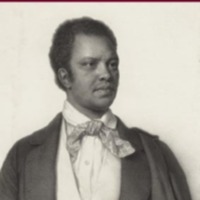
Events to mark the bicentenary in the City of Westminster
In 2007 Westminster City Council supported a programme of events in the libraries, galleries and archives of the area, including films, walks and exhibitions, designed to provide opportunities to learn about the culture of Westminster's communities. Highlights included guided heritage walks with historian S. I. Martin, exhibitions of images from the Royal Geographical Society in Paddington Library, Maida Vale Library and Westminster Reference Library, and film screenings (in partnership with 100 Black Men of London). A partnership between the City of Westminster Archives Centre, Tate Britain, Parliamentary Archives, National Gallery and National Portrait Gallery produced a heritage trail 'On the Road to Abolition: Ending the British Slave Trade', which takes in key sites, events and individuals in Westminster relating to the slave trade, between Trafalgar Square and Pimlico. In celebration of Black History Month, Westminster City Council produced a booklet, 'Black History in Westminster', detailing some of the borough's influential Black residents.
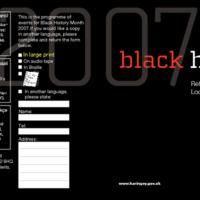
Haringey Council Black History Month
In consultation with the Black community in Haringey, the programme for Black History Month 2007 included many events to commemorate the bicentenary of the Abolition Act. Several took place at the Marcus Garvey Library in Tottenham, including poetry writing workshops, African drumming and dance workshops, and an exhibition and presentations led by Anti-Slavery International. There were several events to mark the bicentenary, including by Bedale House Supported Housing Scheme (featuring tenants' video diaries, a short film, poetry and guest speakers) and by Efiba Arts, supported by The Bridge New Deal for Communities. Haringey Council ran a poetry competition on the theme of slavery for young people aged 13-15. The winning entries were published in a pamphlet distributed to schools and libraries in the borough. Historian S. I. Martin led a guided tour of Haringey's places relating to the abolition of the slave trade. There was also a series of seminars by Robin Walker addressing 'Transatlantic Enslavement: What really happened?'.
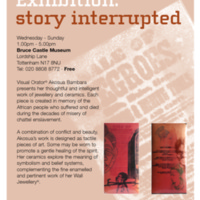
Story Interrupted
Story Interrupted was an exhibition of jewellery and ceramics by visual orator Akosua Bambara at Bruce Castle Museum. Each piece was created in memory of African people who suffered and died in enslavement.
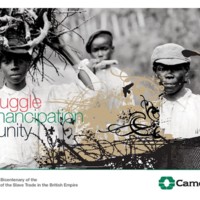
Struggle, Emancipation and Unity
The year-long programme of commemorative events from Camden Council was put together in consultation with the 1807-2007 Taskforce of local African and Caribbean community leaders. The key to these events was remembering slavery through the resistance of Africans, their celebration in their liberation and their unity in tackling present-day inequalities. Camden’s 18th and 19th Century Slavery Trail was created around the area. In eight stops, it explored the lives of men and women connected to the slave trade who lived and worked in the London Borough of Camden. The Resistance Film Season, in partnership with the British Museum, explored the legacy of the slave trade through a mixture of contemporary and classic films. Other events also included local exhibitions, poetry readings, debates and talks.
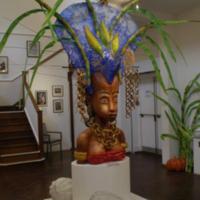
Parallel Views: Black History in Richmond
The Parallel Views exhibition and its associated community engagement programme explored the relevance of the bicentenary for communities in the London Borough of Richmond upon Thames, uncovering local associations with slavery and its abolition. It also told the parallel story of twin town Richmond, Virginia, USA, to broaden understanding of the transatlantic slave trade and the impact of its demise. The exhibition examined evidence of individuals of African origin who had come to Richmond, and residents with financial links to slavery and the slave trade, and to abolitionism. A film piece by choreographer and dance historian Dr Rodreguez King-Dorset explored the use of dance within the free Black community in London during the era of abolition. A display of contemporary artwork responded to the ideas of the exhibition. A sculpture by carnival artist Carl Gabriel linked consumers in Richmond and the conditions of production of slave-grown crops. The design was inspired by a series of workshops with local families. Artist-led workshops for children and young people led to the creation of a carnival costume piece which was included in the exhibition.
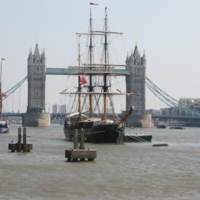
Spirit of Wilberforce
The Centre for Contemporary Ministry (CCM) is an educational charity specialising in the study of contemporary social issues. The CCM established a slavery exhibition at their base, Moggerhanger Park in Bedfordshire, once country home of members of the Thornton family, cousins of William Wilberforce. A mobile travelling display toured local venues. ‘Free at Last?’ was also part of the Spirit of Wilberforce project. This initiative saw a replica of the 18th century slave ship ‘Zong’ sail into London on 29 March 2007. The replica ship was accompanied up the River Thames by HMS Northumberland as part of the Royal Navy’s contributions to the bicentenary. The ‘Slavery Past and Present’ exhibition on board the replica was opened by the Mayor of London – a virtual reality display depicted conditions on a slave ship. The exhibition continued at the church All Hallows by the Tower, exploring the work of the abolitionists and the legacy of slavery. HMS Northumberland also opened to the public - an exhibition on board explored the role of the Royal Navy in enforcing the 1807 Act.
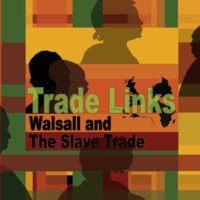
Trade Links: Walsall and the Slave Trade
An exhibition at Walsall Museum looked at Walsall's links with the slave trade, the background to the Abolition Act of 1807, and the legacies of slavery. Walsall's metal industry included chain making by local women of Cradley Heath, and the manufacture of guns used to trade for captive Africans. The exhibition was accompanied by a programme of presentations, lectures and workshops, including art sessions with local residents and the artist Pauline Bailey. Part of the wider project featured an online resource 'Abolition WYA' by Walsall Youth Arts, which encouraged young people to explore the topic of slavery and contribute poems, visual arts and music to express their views. Some of the images featured on the site are pictured here.
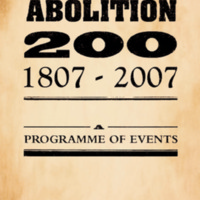
Abolition 200
A programme of events from Wolverhampton City Council to mark the bicentenary, which included a public debate about whether the British government should apologise for the slave trade, services of remembrance and film screenings. Other highlights included stories from Wolverhampton City Archives about the city's role in sustaining the slave trade, and abolishing it, and a discussion and writing workshop with the black writer Fred D'Aguiar and members of Wolverhampton's Black Readers and Writers group. 'Our Ancestors, Our Heritage, Our Stories' was a showcase event highlighting the work of the African Caribbean Community Panel.